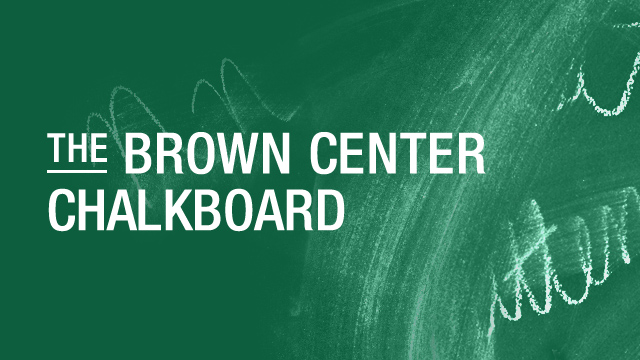Policy debates about investments in early childhood education (ECE) often get stuck in a long-standing research conundrum: the so-called “fade out” effect. That is, large-scale public ECE programs, like Head Start, typically produce short-term improvements in academic outcomes before non-attendees catch up in the early elementary school years. This has led some policymakers to question the returns on investing in public ECE programs. Maybe—the argument goes—ECE slightly speeds up the learning of the most basic academic skills (e.g., counting and letter recognition) that nearly all students will quickly master anyway.
Interestingly, though, when researchers track public ECE participants all the way into adulthood, positive effects tend to reappear. They come in the form of increased educational attainment and lower rates of criminal behavior, among other important outcomes. Also interesting, there’s growing evidence that fade out might not occur when students who attended ECE are grouped with other students who attended ECE (perhaps because they aren’t slowed down by classmates who need to catch up).
That is to say, the causal effects of attending a public ECE program on students are complex and open to interpretation. Some of us see strong, positive effects on long-term outcomes that matter both for these individuals and society at large. Others are wary because of the perhaps-limited effects on elementary school performance.
However, missing from this “fade out” conversation is another key component of the return-on-investment question: ECE may profoundly affect students’ families, not just students’ readiness for kindergarten. Two recent studies reveal just how much parents (or other caregivers) benefit from having access to free ECE programs. These studies, which I describe below, remind us that when we’re thinking about ROI in public ECE, we need to think about more than just the students who enroll in these programs.
Study #1: New Haven ECE program evaluation shows positive effects on family income
Humphries, Neilson, Ye, and Zimmerman (2025) used the New Haven preschool lottery for 3- and 4-year-olds to study the impact of winning a seat on parents’ incomes. To do this, they linked preschool application data to income records in the state unemployment insurance database. New Haven’s preschool spots are allocated first by priority group and then by random lottery tiebreakers (as in many K-12 school choice lotteries). This creates an opportunity for research, as the random lottery process eliminates the potential for other pressures (e.g., more resourced parents’ sorting behavior) from confounding the study’s estimates. The authors can, therefore, use these lottery tiebreakers to isolate the causal effects of enrolling in a public preschool program on families’ incomes.1
The authors found that winning a seat in a preschool program substantially increased parents’ incomes during the child’s preschool enrollment and, notably, for at least six years beyond. During the preschool years, families’ incomes increased by an estimated $5,464 annually. That’s about a 20% increase above baseline. The increased tax revenue from parents’ additional earnings over time substantially offset the cost of the program, reducing the actual cost of providing high-quality, full-day care. Using survey data, the authors found that the increase in income was primarily due to parents’ increased work hours, facilitated by the full-day program, which had notably longer hours than other options available at the time.
Study #2: National analysis of kindergarten expansion finds increase in parents’ labor force participation
A study by Gibbs, Wikle, and Wilson (2024) corroborates the finding that increased public ECE leads to parents’ increased labor force participation. These authors examined state expansions of full-day kindergarten in the 1990s and 2000s, combining data from multiple national surveys to estimate the effect of free access to full-day kindergarten on parents’ employment, time use, and child care expenses. Although kindergarten is now considered part of elementary education, not ECE, this study is directly relevant to ECE because it shows the effects of extending full-day schooling one year earlier in children’s lives.
Gibbs and colleagues used what’s called a triple-difference approach to isolate the effects of full-day kindergarten on parents’ outcomes.2 They found that the availability of full-day kindergarten directly increased mothers’ employment by 5 percentage points, and mothers with access to full-day kindergarten spent about one additional hour per day working, on average. Importantly, full-day care did not decrease the quality time that mothers spent with children. Also, children’s average test scores increased – indicating that the shift for children from time spent at home to time spent at school was beneficial academically and not detrimental to children’s home relationships.
Thinking more holistically about ROI in public ECE
Parents with children too young for full-day elementary school programs have two options: a parent stays home to care for the child, or they find child care. Without a good public option, most parents’ budgets take a substantial hit, either through forgoing income or paying for child care. Market rates for child care have soared to unsustainable levels for most parents. This bind is bad for children, families, and employers alike.
About half of 3-to-4-year-olds nationwide are not enrolled in preschool. That translates to roughly 7.5 million parents who might choose to increase their labor force participation with a public ECE option. These two studies provide strong evidence of the impact of ECE on parents’ labor market participation and income. Participating in free public ECE means that parents have more income to support their families and invest in their children, because they can work longer hours and are not paying for child care.
Notably, both studies found that the benefits of public ECE for employment and income are not limited to disadvantaged families. These programs helped parents across demographic groups, income levels, and marital statuses. (Both programs studied are universal with no income restrictions on participation.) And though the full-day kindergarten expansion only had a measurable impact on mothers’ employment, the universal pre-K study found increased income for both mothers and fathers.
The New Haven study actually found that the effects of ECE on parental income were larger for higher-income families—a function of the larger return to increased work hours for parents with higher hourly wages. Including the parents’ labor market responses, universal ECE programs may theoretically result in larger returns to the economy than targeted programs. The authors go a step further, arguing that universal pre-K offers larger benefits to adults than many popular work incentive programs and tax benefits, including job training programs, unemployment insurance, and the Earned Income Tax Credit.
Businesses and policymakers concerned about labor supply should look to universal, free public ECE programs as a potential solution. Most parents of young children are of prime working age, and many are educated, skilled, and willing workers who are constrained by the limited availability and cost of child care. Investing in public ECE is an investment not only in children’s readiness for school but also in their parents’ career potential and contributions to the economy.
Even if academic advantages of early education fade as other children catch up in elementary school, the benefits of having parents with stable employment and self-sufficient incomes are long-lasting—and set children up for success in adulthood.
-
Footnotes
- Specifically, the authors generated propensity scores for preschool placement—i.e., each student’s likelihood of winning a seat—by repeatedly simulating the placement process with random lottery numbers. This propensity score serves as an instrument for enrolling in preschool in an instrumental variable analysis, where the lottery number affects parents’ income only through preschool enrollment. This approach avoids biases that arise from other factors affecting who enrolls in the program, like students’ priorities or families’ preferences.
- They used a model that estimates parents’ outcomes as a function of changes in state full-day kindergarten enrollment over time (difference 1) and across states (difference 2) in conjunction with having a kindergarten-aged child (5 to 6 years old), therefore exposed to expansions in full-day kindergarten—versus a slightly older 7- to 9-year-old child (difference 3). The models contain fixed effects that compare parents only to those in their state and metropolitan statistical area (MSA) within the same year. The authors also use an instrumental variables analysis that uses state-level policy changes to explain variation in full-day kindergarten enrollment (and find similar results).
The Brookings Institution is committed to quality, independence, and impact.
We are supported by a diverse array of funders. In line with our values and policies, each Brookings publication represents the sole views of its author(s).







